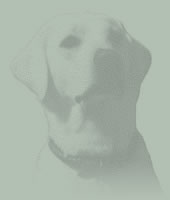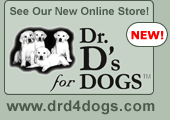 |
Sign Up For Our Newsletter!
 |
||
Veterinary Topics: Feeding the Adult LabradorSee Also: Reproduction | Preventative
Medicine | Obstetrics | Neonatal
Care
This brings up an important point regarding feeding the adult, and although it follows a reference to rapid eating, what I'm about to say is realtive to all Labradors, whether they eat slowly or inhale their food. The condition is called gastric dilatation and torsion and is a very serious and often life threatening situation that can affect not only the Labrador Retriever, but many of the medium to large canine breeds. While it is not our intention to discuss the various medical features of this condition, you should be aware that in many cases it is preventable and that will be the focus of our discussion. As the name implies, gastric dilatation refers to a rapid expansion of the stomach due to gas accumulation and build up. As the stomach swells and pressure increases, the dog experiences a diminshed ability to breath accompanied by a decreased capacity of the heart to pump blood to the vital organs.When a gastric torsion (twisting, as you would twist a balloon) occurs as well as a dilatation, the condition is very critical and surgical intervention is not far away. The condition usually presents with a dog in various degrees of distress characterized by panting, elevated heart rate and a moderate to severely distended abdomen. Immediate veterinary attention is required and any time wasted may compromise the animal's chances for survival. There are several things that you, his master, can do to minimize the risk of this happening to your pet. So as not to give the "do as I say, not as I do" impression, I can tell you that we follow these simple rules rigidly and advise all of the new puppy owners of the benefits. Rather than merely stating my case, a brief exercise will go much further in demonstrating my point. I would like you to stop reading this topic right now (well, after the next sentence or two!) and go to your dog food bag with a regular water glass in your hand. Use a drinking glass that is clear and not colored, for a better picture of what will develop. If you would, fill the glass "half-full" with the dry dog food that you feed. Now fill with water until it reaches the same level as the dog food you just put in the glass. Now set it aside and observe the following: Within seconds, you'll see hundreds of tiny air bubbles being released from the nuggets as they are being displaced by the water. Gradually, the dog food will absorb more and more water and begin to swell, very much like a sponge would do. After five to ten minutes (depending on the density of the nuggets you are feeding) you will see the amount of expansion that the dog food has undergone. What you won't see is the total amount of air (gas) generated in the absorption process. You saw the tiny air bubbles rise through the water. But what you didn't see was how much was given off because it was released into the room. This is nearly the exact sequence of events that occurs when your dog eats plain dry food. Some dogs chew the nuggets more so than others. In any case, realize that after eating, the entire contents of the bowl you just fed is now located in your dog's stomach. And after eating, what does every dog do? They drink water. Of course! And what happens in their stomach? Just remember the glass experiment. The critical difference? You'll remember in the glass example, the air bubbles were released into the atmosphere. In your dog's stomach, the gas has no immediate escape. If you complicate the matter by letting him run around or exercise immediately after eating, you have just initiated a game of russian roulette with your pet's life. So here's how we feed all of our adult dogs. After putting the portions of dry dog food in each dog's bowl, we then add warm water just up to the level of the nuggets. We let it sit for five to ten minutes on the countertop before feeding so that the absorption/expansion process occurs in the bowl, not in their stomach! We allow them to have water after feeding but we do restrict exercise for an hour or so as an added precautionary measure. This process does not seem to affect young puppies, perhaps in part due to the pronounced gastro-colic reflex mechanism that we referred to in the previous section on Feeding Your New Puppy. Thus our discussion is primarily directed at the adult. Following these simple steps can go a long way to protecting your pet from a most devastating disease process. Dr. Joseph Demichael |
||
The Story of Bainbridge | About Us | What Others Are Saying | Memorials | The Home Team | Photography | Your New Puppy | Veterinary Topics | Dr.'s Newsletter | Contact Us | Online Store | Links | Home Page
White Labs by Dr. Joseph Demichael, DVM - The
Labradors of Bainbridge
Ph: (859) 299-6200 | Email: whitelabs@bainbridgelabs.com | Site
Map
© Dr. D’s for Dogs (USA) 2010, Lexington, Kentucky
All worldwide rights reserved. Dr. D’s for Dogs is a trademark
of Dr. J. Demichael, DVM


 Most
adult Labrador Retriever's are hearty eaters and don't have
to be coaxed or pleaded with to eat their dinner. Though
exceptions do exist to every rule (and we have one of those
finicky eaters too), in general, your Labrador will most
likely not leave anything in the bowl to be discarded. Some
Labs are known to eat their dinner so fast that if you blink
your eyes, you might look back to see a pair of pleading
eyes wondering where their food has gone. Rest assured it
wasn't stolen.
Most
adult Labrador Retriever's are hearty eaters and don't have
to be coaxed or pleaded with to eat their dinner. Though
exceptions do exist to every rule (and we have one of those
finicky eaters too), in general, your Labrador will most
likely not leave anything in the bowl to be discarded. Some
Labs are known to eat their dinner so fast that if you blink
your eyes, you might look back to see a pair of pleading
eyes wondering where their food has gone. Rest assured it
wasn't stolen.